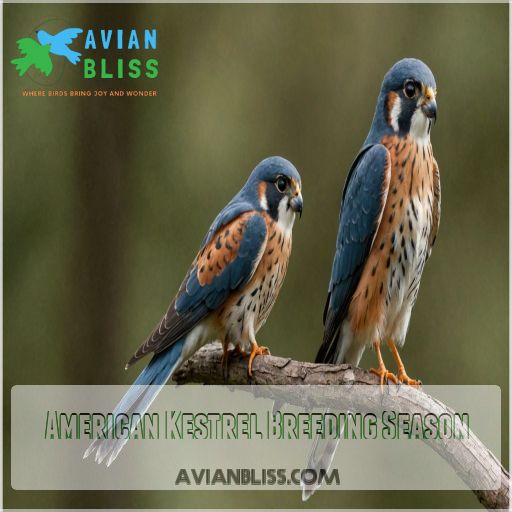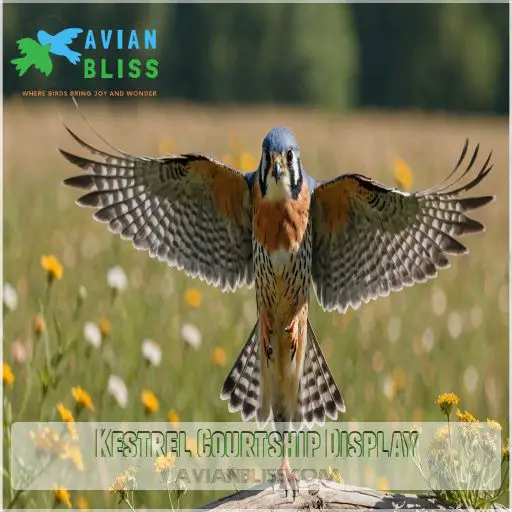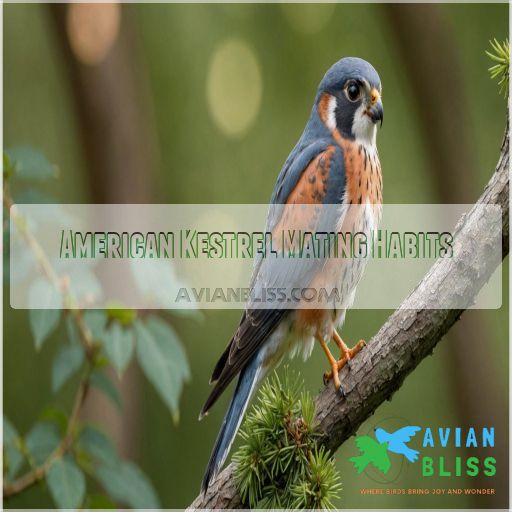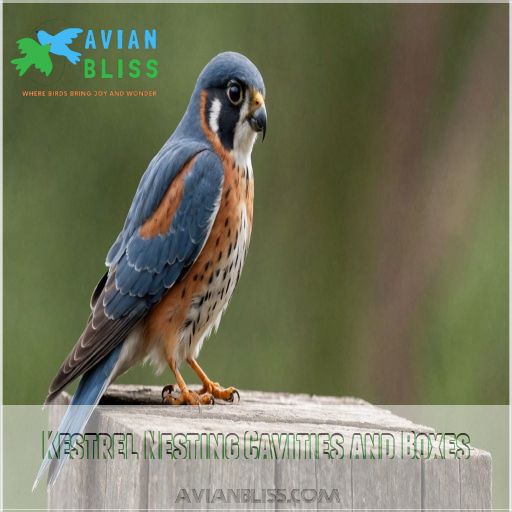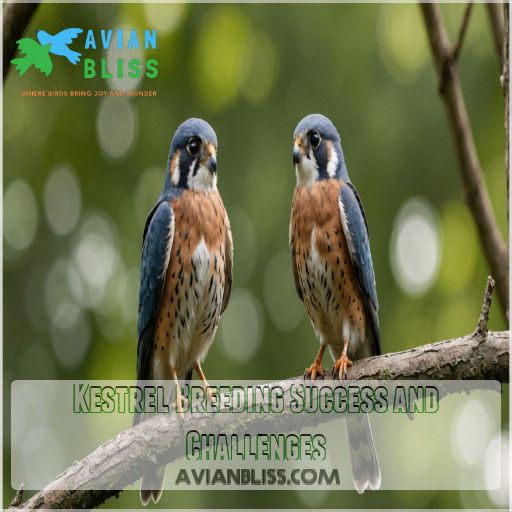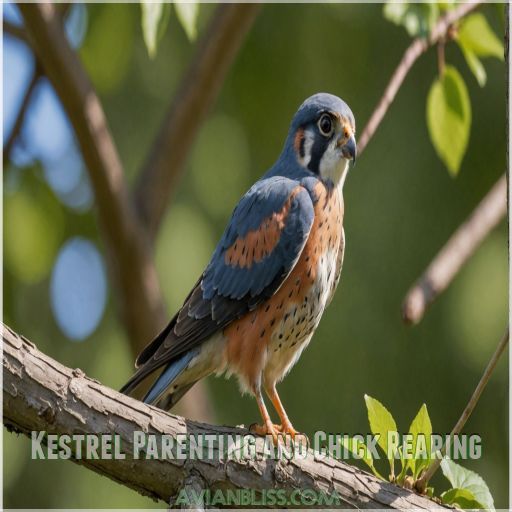This site is supported by our readers. We may earn a commission, at no cost to you, if you purchase through links.
 Ever watched an aerial ballet starring a hawk? That’s american kestrel courtship for you! During the breeding season, which runs from March to July, male kestrels flaunt their airborne acrobatics and keen "klee!" calls to woo their partners.
Ever watched an aerial ballet starring a hawk? That’s american kestrel courtship for you! During the breeding season, which runs from March to July, male kestrels flaunt their airborne acrobatics and keen "klee!" calls to woo their partners.
It’s like the avian version of a grand romance movie. Male kestrels aren’t just show-offs; they bring food gifts and scout perfect nesting spots to charm females.
This impressive courtship display leads to monogamous relationships, where both parents play key roles. Curious about how they juggle parenting and defense? The secret life of kestrels reveals more surprising twists and turns than their migration patterns.
Table Of Contents
- Key Takeaways
- American Kestrel Breeding Season
- Kestrel Courtship Display
- American Kestrel Mating Habits
- Kestrel Nesting and Egg-Laying
- Kestrel Nesting Cavities and Boxes
- Kestrel Breeding Success and Challenges
- Kestrel Parenting and Chick Rearing
- Frequently Asked Questions (FAQs)
- What are kestrel mating habits?
- What is the common kestrel courtship?
- Do kestrels nest in the same place every year?
- What time of year do American Kestrels nest?
- What time of day do kestrels mate?
- How does climate change affect kestrel breeding?
- Are kestrel breeding patterns consistent annually?
- Do kestrels breed in urban environments?
- How does diet impact kestrel mating success?
- Conclusion
Key Takeaways
- During the American Kestrel’s breeding season, males put on a dazzling show with aerial acrobatics and "klee!" calls, much like a birdie rom-com, to woo their mates. It’s a real sky ballet!
- Kestrels form lifelong monogamous bonds, proving that these falcons are serious about their relationships. Once they’ve sealed the deal with gifts of food and impressive nests, they’re in it for the long haul—no messy divorces here.
- The breeding season from March to July is influenced by factors like climate, food availability, and habitat. So, if food’s scarce or spring arrives early, kestrels need to be as adaptable as a teen picking a college.
- Nesting isn’t just about finding a cavity; kestrels have standards like picky renters. Natural tree cavities are prime real estate, but in a pinch, well-placed nest boxes do the trick too, making conservation efforts a feather in their caps.
American Kestrel Breeding Season
The breeding season for the American kestrel, a small and colorful falcon, is a fascinating time of year.
From **courtship displays** to mating rituals, these adaptable birds showcase their unique behaviors as they prepare to raise the next generation, even adapting to changing weather conditions like rain. [even adapting to changing weather conditions like rain](https://avianbliss.com/where-do-birds-go-when-it-rains/).
Duration of Breeding Season
Imagine basking in the warmth of spring, as the breeding season length varies for American Kestrels.
It generally unfolds over several months: 1. March to July, 2. Latitude influences timing, 3. Food availability matters.
Factors Influencing Breeding Season
You’re curious about what steers the American Kestrel breeding season. Well, it includes climate change, food availability, habitat opportunities, human activities, and predator pressure. Here’s a breakdown:
| Factor | Impact | Example |
|---|---|---|
| Climate Change | Alters season timing | Early springs influence timing |
| Food Availability | Affects success | Fewer insects, fewer babies |
| Habitat Availability | Requires cavities | Old trees provide ideal sites |
| Human Impact | Reduces sites | Urbanization limits options |
| Predator Pressure | Influences behavior | More predators mean risks |
Geographic Variation in Breeding Season
The American Kestrel’s breeding season dances with geographic variation.
Factors like climate, altitude, and habitat diversity play a role.
Think of it as nature’s finely-tuned system – similar to a sharp-shinned hawk adapting amid changing conditions.
Impact of Latitude on Breeding Season
While breeding season varies geographically, latitude plays a key role.
Southern kestrels start earlier due to warmer climates, while northern kestrels wait for spring’s warmth.
Climate change affects this timing, complicating ancient natural rhythms.
Kestrel Courtship Display
When you’re observing kestrels in their breeding season, get ready for a sky show, complete with thrilling aerial maneuvers and unique vocal performances.
Male kestrels pull out all the stops trying to impress potential mates, and it’s like watching a rom-com set in the skies, with food gifts instead of flowers.
Aerial Maneuvers and Vocalizations
To attract mates, male kestrels soar and dive, showcasing their agility. Their distinctive klee! calls echo across the open skies, signaling their readiness to court a willing female.
Male Kestrel’s Role in Courtship
After those mesmerizing aerial displays, the male kestrel impresses with his role in courtship. He charms with:
- Vocalizations like "klee!" calls
- Territory defense
- Presenting food gifts
- Demonstrating nest selection skills.
Female Kestrel’s Response to Courtship
As the male showcases his aerial prowess, the female kestrel watches with keen interest.
Her acceptance is essential for mating success.
If impressed, she signals her approval, often influencing which nest site they’ll choose.
Food Gifts and Courtship Rituals
Imagine the American Kestrel showing affection with food gifts. These rituals have charm and purpose. Here’s what to know:
- Food-gift significance
- Ritual variations
- Prey selection
- Gift-giving frequency
American Kestrel Mating Habits
As devoted partners, American kestrels form monogamous relationships and carefully select their mates.
From courtship rituals to mating frequency, these falcon pairs work together to make sure breeding success in the face of various challenges.
Monogamous Relationships
So, after dinner and a few "klee" calls, you’ve got a kestrel pair.
These birds form monogamous relationships, typically sticking together, minimizing those pesky "divorce rates."
It’s all about long-term success.
Pair Bonding and Mate Selection
In kestrel courtship rituals, male kestrels display impressive dives and calls, catching the female’s eye.
Mate selection criteria might include:
- Hunting skills
- Territory quality
- Nest site accessibility
Pair bonds can last multiple seasons.
Mating Frequency and Success
You’re curious about kestrel mating frequency and success, aren’t you? Here’s a peek into those birdie love affairs:
| Mating Aspect | Frequency | Success Rate |
|---|---|---|
| Kestrel Mating Frequency | Often during season | High |
Factors Influencing Mating Success
Mating success for American kestrels depends on several factors:
- Abundant prey to feed offspring
- Suitable nesting cavities to raise young
- Impressive aerial displays to attract mates
Kestrels with access to these resources are more likely to successfully reproduce and pass on their genes.
Kestrel Nesting and Egg-Laying
If you’re talking about nesting and egg-laying, you can’t help but admire the American Kestrel’s knack for finding the perfect spot and getting down to business.
These little falcons are experts at picking and prepping their nesting sites, laying a clutch of 4-5 eggs, and then letting the female take charge of incubation like the ultimate feathered boss.
Nest Site Selection and Preparation
Choosing the perfect nest site is like picking a cozy apartment.
Kestrels look for **natural cavities** or nest boxes, balancing cavity suitability and habitat preference amidst fierce nest site competition, much like burrowing owls [often repurpose abandoned prairie dog or ground squirrel burrows](https://avianbliss.com/burrowing-owl/).
Material collection isn’t needed!
Egg-Laying and Clutch Size
Imagine you’re a kestrel picking the perfect nursery! Egg laying varies from 4-7 eggs, with sizes influenced by:
- Egg color variation
- Nest site impact
- Clutch size range
- Egg laying order
- Incubation duration
Magic happens when nature calls!
Incubation Period and Female’s Role
During the incubation period, the female kestrel takes the lead, carefully tending to the variable-colored eggs in her clutch of 4-7. Her dedication guarantees the chicks’ successful arrival.
Male’s Role in Nesting and Incubation
While the female incubates, don’t count the male out—he’s busy defending the nest site, finding food, and watching over the brood.
Think of him as the family’s pillaring support system!
Kestrel Nesting Cavities and Boxes
Discover how American Kestrels choose their nests, whether naturally made cavities or human-built boxes.
You might say they’re picky tenants, but lucky for them, resources like nest box programs offer the perfect blend of safety and convenience!
Natural Nesting Cavities
American Kestrels often pick natural cavities for their nests, favoring those left by woodpeckers. Natural cavities, however, face decline due to habitat loss and predator threats, impacting nesting success.
- Best cavity size
- Predator threats
- Suitable nesting materials
- Woodpecker impact
- Natural cavity decline
Nest Box Programs and Conservation
nest box programs are a boon for kestrel conservation, allowing volunteers to erect custom-built homes and monitor populations. These efforts help offset habitat loss, boosting numbers through targeted management.
Benefits of Nest Boxes for Kestrels
Learn about kestrel survival and conservation!
Nest box programs foster population growth and breeding success by providing prime nesting sites.
They’re a game-changer in the conservation impact of these feathered beauties (Source).
Installation and Maintenance of Nest Boxes
- Choose durable nest box materials
- Make sure the box is in the right spot
- Regularly monitor boxes
- Make "cleaning boxes" fun!
Kestrel Breeding Success and Challenges
You’re going to learn how American Kestrel breeding success is influenced by factors like habitat loss and innovative nest box programs, like those used for Peregrine falcons.
It’s like being a matchmaker for these falcons, where providing the right nesting space can face challenges but offers hope in conserving their populations.
Factors Influencing Breeding Success
Kestrel breeding success hinges on ample habitat, plentiful prey, and securing prime nesting spots.
Adapting to changing conditions is key, as these raptors face mounting challenges from human activity and climate shifts.
Threats to Kestrel Breeding and Populations
When kestrel dreams clash with reality, habitat loss and climate change stir trouble.
Pesticide exposure and nest site competition add to the problem.
This creates a recipe for prey scarcity that stirs frustration.
Conservation Efforts and Nest Box Programs
Conservation efforts spark hope! Addressing threats to kestrel breeding, you can support kestrel populations by:
- Supporting nest box programs
- Participating in community involvement
- Encouraging nest box monitoring
These actions aid kestrels’ comeback!
Impact of Habitat Loss and Fragmentation
Habitat loss is a thief, sneaking precious nesting spots from kestrels.
Fragmentation effects challenge their survival, but your efforts matter.
Support conservation and nest box programs to help reverse the kestrel decline—a rewarding, impactful endeavor.
Kestrel Parenting and Chick Rearing
Once the eggs hatch, American kestrel parents must work tirelessly to feed and care for their chicks.
Fledging is a process that the parents will guide the young birds through.
The young birds’ parents will also provide post-fledging support to help them survive.
Parental Care and Chick Development
Now let’s focus on parents’ roles after nesting.
They tirelessly protect their chicks, monitoring nestling behavior for signs of fledgling success.
It’s like a feathered family sitcom, full of laughs, drama, and love.
Food Provisioning and Chick Growth
Picture a bustling Kestrel family breakfast: parents diligently provide diverse food sources, ensuring their chicks’ growth rate flourishes.
Each meal boosts development, as feeding frequency and devoted parental care keep these hungry mouths fed and thriving.
Fledging and Independence
Once kestrel chicks grow, they’re ready for the real world: fledging! It’s like their graduation ceremony.
They’ll practice:
- Prey capture like mini ninjas,
- Juvenile dispersal,
- And habitat selection skills.
Post-Fledging Care and Juvenile Survival
After fledging, attentive parents continue guiding young kestrels, teaching them essential hunting and survival skills. With parental support, these resilient juveniles overcome predator threats and thrive in their new-found independence.
Frequently Asked Questions (FAQs)
What are kestrel mating habits?
Kestrels engage in delightful courtship displays with males performing aerial acrobatics and "klee!" calls to woo their mates.
Once impressed, the female joins him, and after some food exchanges, they commence mating rituals.
It’s all about connection!
What is the common kestrel courtship?
You’ll witness an impressive courtship display from the male kestrel.
He’ll soar and dive, showcasing his aerial prowess to woo the female.
Once she’s impressed, they’ll mate, sealing their bond for the breeding season ahead.
Do kestrels nest in the same place every year?
You’re wondering if kestrels are creatures of habit, eh?
Well, these smart birds often return to their previous nesting sites if they’re undisturbed and the location remains suitable.
It’s like re-booking your favorite vacation spot!
What time of year do American Kestrels nest?
While most stay focused on work, the world’s kestrels start families in spring.
Their nesting season kicks off from March to June, peaking their courtship, family tango, and liven life amid their adorable antics that fill skies.
What time of day do kestrels mate?
Kestrels don’t hold a strict schedule, but like many birds, they generally mate during the daytime.
Picture a feathered Romeo, seizing daylight moments, performing aerial acrobatics to woo his Juliet as nature intended.
How does climate change affect kestrel breeding?
Climate change is altering when American kestrels breed, with birds in the south starting earlier than those in the north. (Source) This can impact their nesting success and survival rates.
Are kestrel breeding patterns consistent annually?
You might say kestrel breeding patterns are predictably unpredictable; they’re influenced by latitude and environmental conditions each year.
As seasons whisper changes across the landscape, kestrels adjust their timing, mixing routine with adaptation.
Nature’s way, eh?
Do kestrels breed in urban environments?
American Kestrels are adaptable and do breed in urban environments, utilizing structures like buildings and utility poles for nesting.
They’re the avian equivalent of city slickers, thriving where other birds might hesitate (Source).
How does diet impact kestrel mating success?
In nature’s buffet, kestrels thrive when their plates overflow.
A diverse diet, rich in insects and small animals, boosts energy, improving courtship prowess and offspring viability, ensuring success in the aerial dance of life.
Conclusion
Like a graceful dance in the sky, the American kestrel’s breeding season is a fascinating display of courtship, mating, and parenting.
From the male’s aerial acrobatics to the monogamous pair’s teamwork in nesting and chick-rearing, these falcons showcase nature’s wonders, much like the black-legged kittiwake’s unique foraging techniques.
Whether observing their "klee!" calls or marveling at their nest box occupancy, you’ll be enthralled by the American kestrel breeding season’s charming intricacies.

